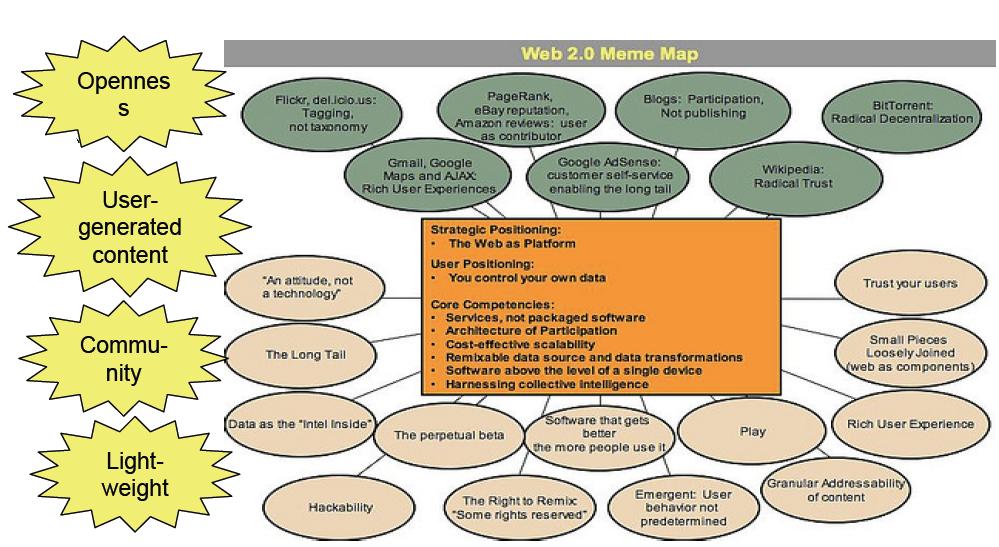Difference between revisions of "What is Web 2.0?"
| (14 intermediate revisions by the same user not shown) | |||
| Line 1: | Line 1: | ||
"[This is] '''not my mom's Internet'''…It's changing, and it's changing because we're looking at the share-shifting—the time people are looking at TV, reading a magazine, listening to the radio—they're not replacing each other; they're coming together." - AOL Exec / May 2005 | "[This is] '''not my mom's Internet'''…It's changing, and it's changing because we're looking at the share-shifting—the time people are looking at TV, reading a magazine, listening to the radio—they're not replacing each other; they're coming together." - AOL Exec / May 2005 | ||
'''According to Wikipedia:''' | '''According to Wikipedia:''' | ||
Web 2.0 generally refers to a second generation of services available on the World Wide Web that allows people to collaborate and share information online. In contrast to the first generation, Web 2.0 gives users an experience closer to desktop applications rather than traditional static Web pages. The term was popularized by O'Reilly Media and MediaLive International as the name for a series of web development conferences that started in October 2004. Web 2.0 applications often use a combination of techniques devised in the late 1990s, including public web service APIs (dating from 1998), Ajax (1998), and web syndication (1997). They often allow for mass publishing (web-based social software). The term may include blogs and wikis. To some extent Web 2.0 is a buzzword, incorporating whatever is newly popular on the Web (such as tags and podcasts), and its meaning is still in flux. | |||
[[Image:Web_2.0_meme.JPG]] | |||
'''Major Retailers''' | '''Market Drivers of Web 2.0''' | ||
- Amazon API's | |||
- Google Adsense API | While the term might have appeared out of nowhere, the underlying fundamentals of this evolutionary shift stay the same: | ||
- Yahoo API | |||
- Ebay API | - Broadband has become mainstream and ubiquitous resulting in an increased usage of the internet for even small tasks on different devices. | ||
- More people online for a wide variety of tasks and shopping related activites. | |||
- The founders and executive management of the first batch of companies have moved on - either joined one of the big players, left to join VC's, or start / join a completely new thing. This means a lot of experience of what did and didn't work is in the mix. | |||
- New ventures can grow more slowly; no pressure to gain VC, costs of starting up are much lower, no hype to cater for ;just good products and solid revenues. | |||
In summary, there is a web 2.0 feel about the place meaning a natural evolution rather than a revolution. As before, there will still be a shakeout of businesses as competition increases and the successes work their way to the top. | |||
'''Emerging Technologies''' | |||
- Web Services/API's | |||
- "Folksonomies" / Content tagging | |||
- "AJAX" | |||
- RSS | |||
'''Major Retailers''' | |||
- Amazon API's | |||
- Google Adsense API | |||
- Yahoo API | |||
- Ebay API | |||
'''References:''' | |||
[http://www.answers.com/web%202.0 Answers.com] | |||
[http://www.oreillynet.com/pub/a/oreilly/tim/news/2005/09/30/what-is-web-20.html Oreillynet.com] | |||
[http://en.wikipedia.org/wiki/Web_2.0 Wikipedia.org] | |||
Latest revision as of 21:12, 6 May 2006
"[This is] not my mom's Internet…It's changing, and it's changing because we're looking at the share-shifting—the time people are looking at TV, reading a magazine, listening to the radio—they're not replacing each other; they're coming together." - AOL Exec / May 2005
According to Wikipedia:
Web 2.0 generally refers to a second generation of services available on the World Wide Web that allows people to collaborate and share information online. In contrast to the first generation, Web 2.0 gives users an experience closer to desktop applications rather than traditional static Web pages. The term was popularized by O'Reilly Media and MediaLive International as the name for a series of web development conferences that started in October 2004. Web 2.0 applications often use a combination of techniques devised in the late 1990s, including public web service APIs (dating from 1998), Ajax (1998), and web syndication (1997). They often allow for mass publishing (web-based social software). The term may include blogs and wikis. To some extent Web 2.0 is a buzzword, incorporating whatever is newly popular on the Web (such as tags and podcasts), and its meaning is still in flux.
Market Drivers of Web 2.0
While the term might have appeared out of nowhere, the underlying fundamentals of this evolutionary shift stay the same:
- Broadband has become mainstream and ubiquitous resulting in an increased usage of the internet for even small tasks on different devices.
- More people online for a wide variety of tasks and shopping related activites.
- The founders and executive management of the first batch of companies have moved on - either joined one of the big players, left to join VC's, or start / join a completely new thing. This means a lot of experience of what did and didn't work is in the mix.
- New ventures can grow more slowly; no pressure to gain VC, costs of starting up are much lower, no hype to cater for ;just good products and solid revenues.
In summary, there is a web 2.0 feel about the place meaning a natural evolution rather than a revolution. As before, there will still be a shakeout of businesses as competition increases and the successes work their way to the top.
Emerging Technologies
- Web Services/API's
- "Folksonomies" / Content tagging
- "AJAX"
- RSS
Major Retailers
- Amazon API's
- Google Adsense API
- Yahoo API
- Ebay API
References:
